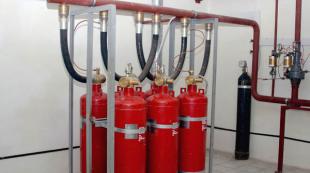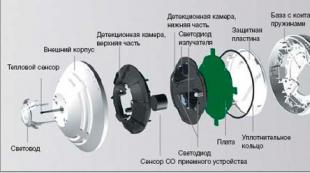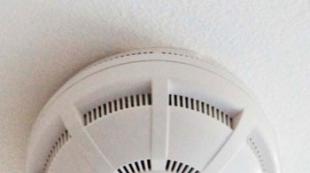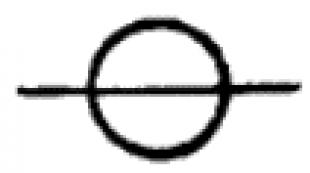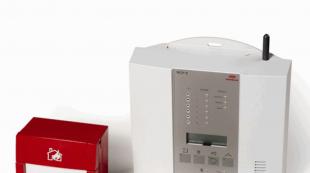The best antenna for digital television. How to choose a TV antenna for digital terrestrial television
A modern indoor antenna is not only a practical gadget for setting up digital TV, but also a stylish piece of furniture. This article will tell you about the variety of antennas that exist today and the intricacies of their choice.
1. The main cases of using indoor antennas.
Indoor antennas are primarily used in situations where the house is located in close proximity to the broadcasting television tower — up to about 10 km. When placed close to the TV tower, it is desirable to use a less sensitive antenna, i.e. often in such situations a simple passive antenna without any amplifier is enough. They also resort to the use of indoor antennas when it is not possible to use an outdoor antenna - for example, when there is no exit to the roof in tenement house. In such a situation, it is especially practical to use the so-called window indoor antennas - they can be mounted on the window. When using a window antenna, it is better to place it on a window that directly goes to the side of the tower, if of course there is such an opportunity. Even window antennas will be an excellent solution in the case when the walls of the house shield the digital signal very strongly, and it practically does not get inside the house. In this case, window antennas can even compete with powerful outdoor antennas.
2. Antenna amplifier: built-in or external?
As already noted above, the choice of antenna gain depends on how far the house or apartment is from the television tower - the closer the house is to the tower, the less sensitive the antenna should be. At the same time, one should not forget about the presence of obstacles in the way of signal transmission from the TV tower: the tower may be close, but there may be small but strongly shielding objects in the signal path. As a rule, indoor antennas are not equipped with powerful amplifiers, but sometimes there are situations when the signal needs to be further amplified. For example, when the antenna is far from the TV, and a long cable is used to connect it - due to the use of a long cable, a weakening of the transmitted signal can be observed. To amplify this signal, it is worth using an external antenna amplifier.
Also, an external amplifier is needed when two or more TVs are connected to the same antenna - in this situation, signal quality may also be lost, and an external antenna amplifier can be used to compensate for it. There are active indoor antennas with a manual control of the signal reception level - for example, the models "" and "". However, we draw attention to the fact that in a situation where the incoming signal is blocked by the walls of the house and the signal is difficult to catch indoors, it is better to use an antenna with automatic adjustment of the signal reception level.

3. Power the indoor antenna.
Indoor antennas can have different power sources. Some antennas have external power supplies that come with them, some models of antennas can be powered by TVs or digital receivers. However, it is worth noting that not all TVs have the appropriate functionality for powering the antenna. At the same time, almost all digital receivers have this feature. As a rule, the receivers menu has such an option as “Turn on the power of the external antenna” - when this option is activated, the antenna will constantly receive power from the receiver. Today, there are also some antenna models that are powered by the receiver / TV by connecting to the latter via USB. For example, the model "".
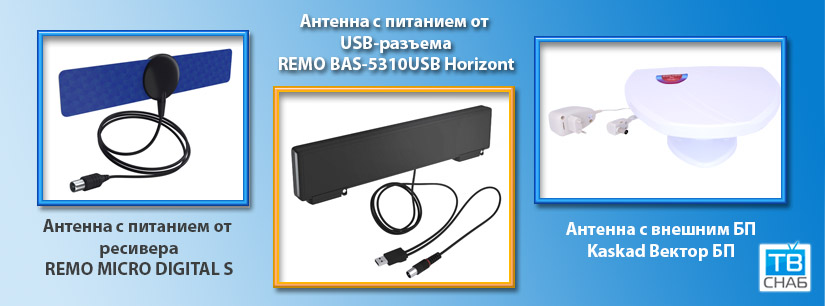
4. Is the antenna digital or universal?
When choosing a room antenna, you should immediately decide what type of signal you plan to receive on it. If you need only a digital signal, then preference can be given exclusively to digital or decimeter antennas. If, in addition to a digital signal, you need to receive and configure an analog signal (for example, when local TV channels are broadcast in the region that you also want to receive), then you should pay attention to universal antennas. Universal antennas receive all types of transmitted signals and, as a rule, have movable telescopic deflectors or the so-called "whiskers" in their design.
5. Modern antenna designs.
Modern versions of indoor antennas will please the most sophisticated consumer. For example, in our online store there are antennas with a stand for their compact placement on the table and on the shelf, in the presence of antennas that can be attached to the TV on a bracket or on a suction cup. There are also the above-mentioned window antennas, which are attached to the window pane by means of special suction cups, for example the Viva antenna from the Remo brand. The design of modern antennas will please the most sophisticated buyer - along with the usual antennas with a "mustache", there are also antennas with very peculiar designs. For example, a round antenna "
Reception digital tv using a special antenna - it’s much easier to receive analog TV, surprisingly. To enjoy DVB-T2, you just need to purchase one digital antenna UHF range, in which DVB-T2 broadcasts digital channel packets (multiplexes).
Since January 2015, broadcasting of the third multiplex on channel 34, with a wide list of programs, began on the territory of Moscow and the Moscow region from the Ostankino tower. To get access to all programs, you should choose a high-quality and modern antenna, and we will be happy to help you with this.
Firstly, it is clearly worthwhile to separate the antennas for satellite broadcasting and digital:
The optimal antenna for digital television is this antenna model that can provide reliable reception in UHF (often such antennas are called decimeter antennas),
Optimal antennas for satellite broadcasting are dishes, i.e. large outdoor antennas with high gain. Thus, satellite dishes differ from digital broadcast antennas in terms of gain, range and price. It is also worth remembering that an indoor antenna can in no way be satellite.
Secondly, all antennas are divided into two main classes:
Directional antennas are ideal when there is an exact certainty on which side the signal is coming. Such antennas have a higher gain and at the same time they cut off all the interference coming from other sides and increase the sensitivity in a given direction.
Omni-directional antennas - do not require a clear focus towards the TV tower and are very convenient in places where there are various obstacles to the direct signal - high-rise buildings, for example.
Thirdly, at the location of the antenna there are indoor and outdoor. They are also divided into active and passive antennas - depending on the presence of a built-in signal amplifier in the antenna. If you live near a TV tower, then it is advisable to use a passive antenna to receive a digital signal, as using an active model with an amplifier can cause signal distortion. If your house is located at a considerable distance from the TV tower and there are various obstacles to the signal transmission (buildings, trees), it is recommended to use an active antenna with a signal amplifier.

The TV-Snab online store offers a wide range of antennas for receiving a digital dvb-t2 signal from manufacturers such as BBK, Mystery, Rolsen, Supra, Tesler. Among the presented assortment of antennas are indoor and outdoor, passive and active, directional and omnidirectional. Based on a small survey of visitors to our online store, the following rating of antennas for digital TV was formed:
and (the two models differ in color gamut) - the models have a built-in signal amplifier, and are also omnidirectional.
- compact size, stylish design and good technical data: low-noise signal amplifier.
- reliable in operation and easy to use outdoor antenna. It has a stylish and durable waterproof case, equipped with a built-in and external signal amplifier.
- elegant design, signal amplifier, reception of radio signals, as well as the availability of a regulator for fine-tuning the required signal level.
- A convenient and reliable active antenna with an attractive price.
Terrestrial broadcasting is called television broadcasting, in which a TV signal is transmitted by a transmitting television station to the surrounding space using electromagnetic waves, and anyone can pick up this signal using a television receiving antenna. Broadcasting is conducted on meter (MV / VHF) and decimeter (DMV / UHF) waves. In connection with the transition of Russia to the digital broadcasting format, terrestrial television is becoming a convenient and free way to deliver a high-quality television signal. The DVB-T2 standard has been adopted as the main format for digital terrestrial TV in Russia.
Antenna Classification
Television antennas are conventionally divided by the installation site, type of signal amplification, and the range of received frequencies.
- At the installation site - indoor and outdoor.
Indoor antennas are installed indoors. Reception by indoor antenna is possible only where the level of the TV signal is high enough - such places are called areas of reliable reception. In reality, there are not so many such zones. There are not many chances to get a high-quality “picture” using a room antenna in the village, at the cottage, or other places remote from the repeater. Of course, I want to get along with a nice elegant design, and not climb on the roofs and balconies, but the laws of physics cannot be bypassed.
Outdoor antennas have the best options and can be applied in most places, including country houses and cottages. Installing an outdoor antenna requires considerable effort and some experience, but can provide better reception quality!
- By type of signal amplification - passive, active and directional with a high gain.
Passive antennas receive and amplify the signal due to its design (geometry). They do not connect to the electrical network and do not have active amplification elements: transistors, microcircuits, or other electronic components. Thus, passive antenna It does not introduce its own interference and noise (which is inevitably produced by various electronic components) in the received signal. At the same time, in some situations, her own capabilities are not enough for high-quality reception.
Passive small indoor antenna Suitable for receiving a signal at a short distance from the transmitting tower, in low-rise buildings, at an altitude of more than 10 meters.
Active antennas amplify the received signal not only due to the design features, but also using the electronic amplifier with which they are equipped. The amplifier can be mounted inside the antenna housing or separately from it. Power is supplied from the household power supply using an adapter (power supply).
High gain directional antennas suitable for digital reception terrestrial television countryside at a considerable distance from the transmitting television center.
- According to the received frequencies - channel, band and all-wave.
Channel antennas designed to receive only certain frequency channels, used in special conditions - they are practically not needed for a regular viewer.
Band antennas are used where only MV, or only UHF should be taken. In particular, for broadcasting digital terrestrial television in Russia, only the UHF band is used. If the antenna is purchased only for receiving digital TV, then an antenna operating only in the UHF range is sufficient.
All-Wave Antennas able to simultaneously receive signals of both ranges: MV and UHF. Most often, viewers need precisely such antennas, because various television channels in Russia are broadcast both in the MV band and in the UHF band.
Antenna Specifications
An antenna, like any electronic device, has a number of parameters and technical characteristics. Some of them are described in the product passport, some - only in technical conditions. It is unlikely that the average buyer needs all these numbers. Probably the only technical specificationswhich the consumer should pay attention to is the antenna gain or gain. Measured in decibels (dB). The higher the value, the better the antenna’s ability to amplify the TV signal. But not always a large gain will lead to a better image. The gain should match the installation location of the antenna! Sometimes unscrupulous manufacturers or sellers indicate sky-high gain factors in the package and in the product passport that have nothing to do with reality.
Assembly, installation and configuration
The acquisition of an antenna is not all that is needed for high-quality reception of television signals. The antenna must be properly assembled, correctly installed, connected and configured. The assembly is usually described in detail in the product passport or on the packaging. Carefully read the instructions before assembling, or better, before buying! Pay attention to the recommended installation location of the antenna and the procedure for connecting it to the TV to achieve the best reception quality.
The installed antenna must be connected to the TV. This is done using a coaxial cable, which many antennas have in the package. But if the antenna is purchased without a cable (often an outdoor antenna), or the cable is not long enough, you should seriously consider buying it! For television antennas, it is necessary to use a cable with a wave impedance of 75 ohms. This number is indicated on the product itself. Cable quality is made up of the quality of the materials used and the quality of production. The denser the cable sheath and the thicker the central core, the better and usually the more expensive the cable. Do not chase low cost, because a bad cable can negate all the advantages of a good antenna!
Tuning the antenna most often boils down to its correct orientation to the tower. The technique is simple - slowly rotate the antenna in a horizontal plane while observing the quality of the received image. When setting up an outdoor antenna - use the help of a second person.
For indoor antennas, when switching TV channels, situations are possible when it is necessary to change the gain or adjust the position of the MV or UHF antenna parts. This is normal and is a kind of payment for placing the antenna indoors. The antenna setup should be described in detail in her passport.
Viewers often find it difficult to choose the right television antenna. Here, first of all, it is necessary to determine for what tasks the antenna is acquired, in what conditions it has to work. Selecting an antenna in appearance can lead to problems in receiving a signal.
Point the antenna towards the TV tower.
If the windows of the room where the TV is installed are facing the tower, a window antenna may come up to you - it is mounted on the glass, and due to this, although it is a room antenna, in some cases it can compete with an outdoor one.
First, try to turn on the antenna without an amplifier, if you can’t get good quality, turn on the amplifier. It is advisable to install the antenna outdoors - on the outside of the window, on the balcony, mast, etc.
If you plan to connect several television sets to the antenna, you should choose an outdoor antenna, with the best parameters.
Avoid placing the receiving antenna near shielding surfaces and active “jammers”. For example, if you install the antenna in the attic under the roof of a metal tile (“screen”), the signal will be blocked by the roof. Near power lines, extraneous transmitting objects, the reception quality can be significantly reduced.
Examples
SITUATION 1
The apartment is on the top floor of a high-rise building at a short distance from the TV station (3-5 km). The television center is visible from the location of the proposed antenna installation. Here, the best option is an outdoor all-wave antenna without a built-in amplifier. An acceptable level of image quality will be achieved using almost any indoor antenna. If you choose a room antenna with a built-in amplifier, then there must be an adjustment of gain to avoid overloading with a powerful signal. In the case of receiving a signal in digital format DVB-T2, the image quality should be excellent with a room antenna.
SITUATION 2
Similar to the previous situation, but the windows of the apartment overlook the opposite side of the television center. The best option is an outdoor all-wave antenna without an amplifier, mounted on the roof and aimed at the television center. If for some reason this is not possible, you can use a directional indoor antenna. But receiving all channels in good quality is usually not possible. Again, in case of receiving a signal in the digital DVB-T2 format, the image quality should be excellent.
SITUATION 3
Outskirts of the city, high-rise building, apartment on the ground floor. The distance to the telecentre is 10-30 km. The most suitable option is an outdoor active all-wave antenna mounted on the roof. In this case, you will need to additionally purchase a coaxial cable, since usually a small amount of cable (6-8 meters) comes with the antenna. The cable must be selected high-quality, with the least loss, having a dense braid of wires and aluminum foil as a screen. The most commonly used cable size RG6 or SAT-50. Old Soviet PK75 cables have significant attenuation in the UHF range and are practically unsuitable for modern use. The use of indoor antennas in this case is possible only in case of low requirements to the quality of the received signal. High-quality digital television reception is possible with a directional indoor antenna.
SITUATION 4
Cottage or country house at a considerable (over 50 km) distance from the television center. For high-quality reception of all channels, it is necessary to use a professional complex of several band antennas with signal amplification and filtering systems. If it is acceptable that a high-quality image will not be on all channels, then you can use an external all-wave antenna with an amplifier. Indoor antennas in this case are absolutely useless.
In order for the antenna for the TV to work properly and not cause difficulties in working in the country or in the apartment, you need to choose the right indoor (indoor) or outdoor digital device. Several criteria are distinguished when buying a television antenna - signal strength, gain, activity. Check out well-known manufacturers of devices, the secrets of choosing an antenna.
Types of antennas for TV
In Russia, a different signal level of television waves, so home antennas are highly sensitive, which ensures reception in almost any environment. Parabolic, indoor and outdoor antennas are distinguished, which are divided into several more categories. To receive a television wave without interference, you need an individual selection type and power.
Satellite dishes for TV
Parabolic television antennas are popular. They are distinguished by stability, high quality signal reception and an increased number of channels. Equipment of this type consists of a receiver, a receiver for decoding. The antenna receives waves from the satellite, so the clarity of the image depends on locationunit and TV.

Direct focus
In this type, the converter irradiator “looks” below the horizon, which protects the signal receiver from negative atmospheric effects:
- model name: MULTI Toroidal;
- price: 1100 r.;
- characteristics: diameter - 100 cm, reception from 16 satellites;
- pluses: simplicity of addition of channels;
- cons: The quality of receipt varies.
In a small house or in the country, a 60-centimeter is useful satellite dish, which costs a little more than the first:
- model name: Triax TD-064;
- price: 1300 r.;
- characteristics: 60 cm;
- pluses: resistance to precipitation, corrosion;
- cons: The cost of satellite television channels is high.
For those who do not want to bother with a complex design, a ready-made set of satellite television is suitable:
- model name: NTV +;
- price: 7050 r.;
- features: interactive console, movie library;
- pluses: decoding;
- cons: There may be interference.
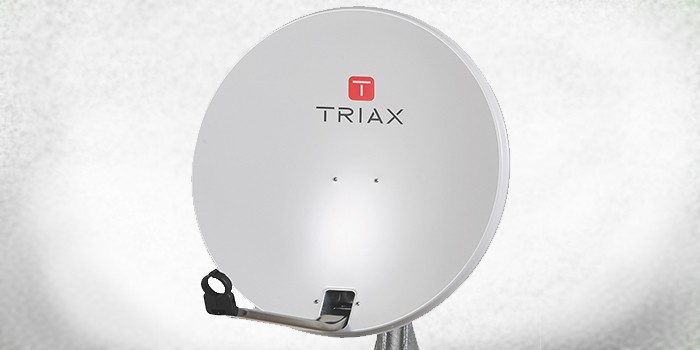
Offset
The advantage of using offset antennas is a larger viewing angle and improved image quality:
- model name: Supral;
- price: 1400 r.;
- characteristics: 80 cm;
- pros: anti-corrosion coating, wall bracket;
- cons: no.
The following subtype, which is suitable for receiving any waves, is slightly larger in diameter:
- model name: Universal;
- price: 1200 r.;
- characteristics: 90 cm, aluminum alloy;
- pluses: compatibility with different TV sockets;
- cons: no mounting.
The third option for offset antenna will be a set of satellite television at an affordable cost:
- model name: D-Color DCA-101;
- price: 253 r.;
- characteristics: sizes 30 * 20 cm;
- pluses: compactness, power amplifier from the console, little noise;
- cons: no.

Outdoor TV Antennas
If the buyer lives away from the TV signal transmitters, then outdoor elements will help strengthen the reception. Street options receive television waves up to 60 km from the transmitter. For the correct selection, you need to know the distance to the nearest tower, find out the need for amplification of the wave. To achieve a high-quality picture, it is recommended to install the unit at the highest point above the house.
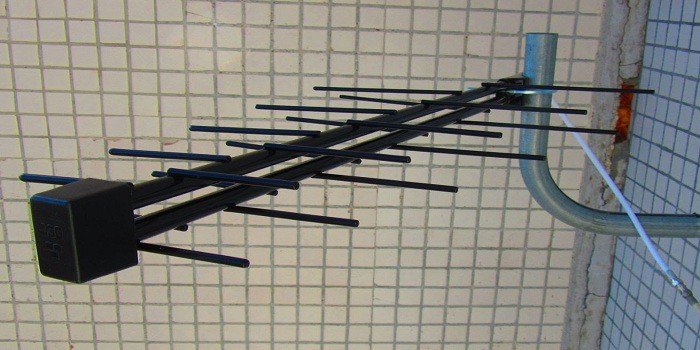
Active
The active antenna for TV is equipped with a special power amplifying device. This helps to increase the clarity of the picture of the TV with a far located TV tower:
- model name: Funke ABM 3553;
- price: 2300 r.;
- characteristics: 75 ohms, size 1.38 m;
- pluses: works in difficult reception conditions, made of anodized aluminum;
- cons: large sizes, no cable and power supply.
A more accessible antenna is the following, characterized by design features:
- model name: Cadena AV;
- price: 1550 p.;
- features: Receive DVB-T / DVB-T 2;
- pluses: there is a bracket;
- cons: power through the adapter.
Another popular affordable budget option will be the following long-range unit:
- model name: Rexant ABM 3529;
- price: 2064 p.;
- characteristics: 68 cm;
- pluses: there is protection against corrosion and ultraviolet radiation;

Passive
In the absence of obstacles, passive devices to the TV can be used, which are cheap and do not need amplifying equipment:
- model name: GELLAN FULLBAND-15;
- price: 1264 p.;
- characteristics: up to 2700 MHz, 50 Ohms, parameters - 240 * 240 * 40 mm, operating conditions - wall;
- pluses: vertical polarization;
- cons: improves the signal at a distance of up to 10 km.
The second popular brand is the Dutch Funke, which is expensive, but justifies the parameters:
- model name: Funke BM 4527;
- price: 1413 r.;
- specifications: 75 ohms, 685 mm;
- pluses: anodized aluminum;
- cons: no cable and power supply.
The third most popular among buyers of TVs is the Locus antenna, which is available at a cost, on sale with discounts:
- model name: Locus L 021.12 antenna;
- price: 1300 r.;
- characteristics: range of 55 km, 1.31 kg, 1.4x2 m;
- pros: ease of assembly;
- cons: no wire.

Rod
A traditional TV antenna has a rod system consisting of metal half-vibrators:
- model name: Jablotron AN-05 GSM;
- price: 1428 r.;
- characteristics: frequency 900-1800 MHz, cable length - 3 m;
- pluses: magnetic base;
- cons: There may be interference.
More expensive and better quality is the goods of another manufacturer that produces dipole devices for TVs:
- model name: ETS-LINDGREN;
- price: 3144 r.;
- characteristics: 80 MHz-2 GHz, parameters - 210x170x9 cm;
- pluses: individual calibration, high gain;
- cons: weight 4.5 kg.
The most expensive device in the collection is the one released by the manufacturer according to military standards:
- model name: Narda RA-01;
- price: 5000 r .;
- characteristics: 9 kHz-30 MHz, weight - 1.5 kg, dimensions - 150x135x120 mm;
- pluses: individual antenna;
- cons: too expensive.

Framework
This subtype is represented by one or several turns of wires connected in one frame, in the plane of which is the maximum intensity of the decimeter frequency range:
- model name: Garmin 220;
- price: 1490 p.;
- characteristics: compact;
- pluses: accepts any programs;
- cons: delivery required.
A simple device is the following, which is a frame winding of a magnetic generating type:
- model name: EMCO 7603;
- price: 1000 r .;
- characteristics: 20 Hz-50 kHz, 16 turns, diameter - 12, height - 8 cm;
- pluses: individual calibration, linear polarization, weight - 0.5 kg
- cons: not found.
A.H.Systems frame antenna for a TV - more affordable, easy to operate:
- model name: A.H.SYSTEMS SAS;
- price: 700 r .;
- characteristics: 1 kHz-30 MHz, 50 Ohms;
- pluses: weight 1 kg, increased structural strength, network adapter and preamplifier included;
- cons: The principle of battery operation.

Indoor TV Antennas
If the signal from the television center is high-quality, an internal pick-up device is suitable, which is more convenient than the external one by the installation method. Such options are cheap, suitable for any TV jack, transportable. Of the minuses - the complexity of image settings. Allocate analog, all-wave, broadband and narrowband varieties.

Digital
This subtype is used to obtain a digital image. With it, you can achieve high-quality images:
- model name: Funke Margon Home 2.0;
- price: 1450 p.;
- specifications: 170-240 MHz;
- pluses: 3.5 m indoor cord;
- cons: not equipped with an outdoor cable.
The following antenna for the TV is more affordable, it can be ordered by mail by promotion:
- model name: BBK DA 19;
- price: 843 p.;
- characteristics: receiving HDTV standards of on-air TV;
- pluses: little noise;
- cons: not found.

All-wave
From the name it follows that the devices accept all kinds of frequencies (decimeter, meter), they are called universal:
- model name: Polish antenna Delta K331A.02;
- price: 1092 r .;
- characteristics: dimensions 280 * 680 * 120 mm;
- pluses: acceptance of any TV programs;
- cons: slight interference.
A domestic manufacturer is considered popular, the products are distinguished by a favorable cost and free delivery when ordering from 3000 rubles:
- model name: SPI 918;
- price: 399 p.;
- specifications: 75 ohms;
- pluses: compact sizes;
- cons: no.

Broadband
The fan or broadband subtype is set to suburban areasfar from the transmitter:
- model name: Ramo Bas 5340 TV JET ANT-USB Horizon;
- price: 580 r.;
- characteristics: log-periodic antenna;
- pros: powered by USB or receiver;
- cons: only works in the sustainable receiving area.
The option installed on the ceiling can significantly enhance reception on any television waves:
- model name: AO-700 / 2700-4;
- price: 599 p.;
- characteristics: weight 300 g, dimensions 185 * 100 mm;
- pluses: dome;
- cons: no wire.

Narrowband
This term refers to narrowly targeted options for TVs that capture a certain frequency, which reduces interference:
- model name: Romsat AV-2845;
- price: 600 p.;
- characteristics: wire length 14 m, telescopic, material - aluminum;
- pluses: not afraid of "wintering" in the country;
- cons: size 1035 mm.
A cheaper device is the simple design of the domestic brand, made of plastic, catching smaller channels:
- model name: Vector-PL-1 K;
- price: 450 r. on sale;
- characteristics: 5-128 V, 75 Ohms;
- pluses: 3 m wire;
- cons: plastic, a short distance from the tower.

With amplifier
Indoor antennas with an amplifier for a TV will help you watch programs with a clear picture and a bright image:
- model name: Delta Satellite in dvb-t2 DS 1000 format;
- price: 1800 r .;
- characteristics: resistance to sun exposure, installation on a mast;
- pluses: the built-in amplifier of a weak signal, catches a signal to 80 km;
- cons: not found.
The following building for a TV that accepts digital and analog television encodings will cost half the price:
- model name: Selenga 101 A;
- price: 843 p.;
- characteristics: cable length 1.2 m;
- pluses: compactness, weight 300 g;
- cons: plastic case.

How to choose a TV antenna
The choice depends on where the design is installed. The remote installation site is suitable for outdoor with an amplifier, city \u200b\u200bapartments - narrow-band, active room, cars - frame. In villages and cottages it is better to install parabolic plates. The choice depends on the criteria of remoteness, price range, amplification factor.

For auto
For high-quality reception of TV, radio, navigator, a combined GPS or GSM car unit is required. Parabolic will take all programs, but it will be expensive. Intra-cabin active all-wave structures are equipped with an amplifier, the external ones are passive, they need an extension cord. Among the shortcomings of the latter, corrosion resistance is noted.

To give
To watch TV in the country, it is better to buy an active design and set it as high as possible. The kit should include an amplifying element and an adapter, you will need to purchase a coaxial cable for charging. The external type should be on the roof. If the TV tower is nearby, the internal device is suitable. To listen to the radio, purchase broadband.

Home
In a city apartment or country house, it is easier to install a room unit on a TV, if before the repeater no more than 30 km. Otherwise, you have to set the external (active or passive) or digital with the tuner. It is better to choose a room rod (meter) or frame (decimeter signals): it is mobile, weighs less, is easily connected.

For digital television
Provide stable reception of weak messages and high-quality TV image parabolic collective antennas. They are distinguished by an expanded channel package, increased stability. At installation it is necessary to consider the location of the unit relative to the broadcast source. Choosing a plate is based on costs and opportunities.



